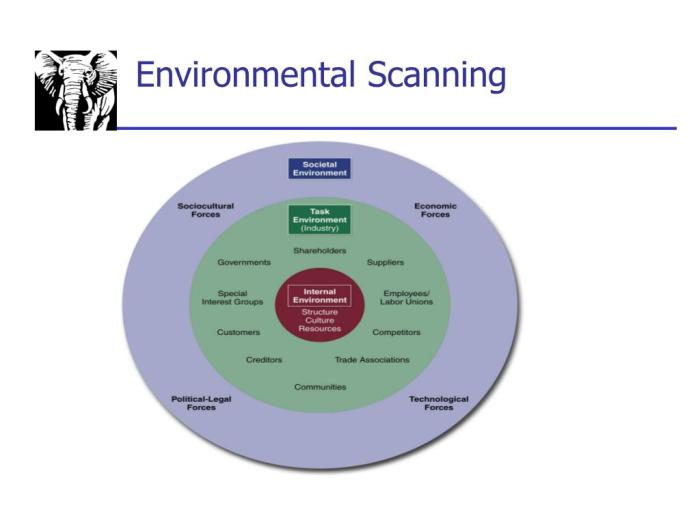
Embark on a journey through the intricate world of Micro and macro business environment, where we unravel the mysteries of small and large-scale influences on businesses, keeping you hooked till the end.
Get ready to explore the dynamic interplay between micro and macro factors shaping the business landscape like never before.
MICRO AND MACRO BUSINESS ENVIRONMENT
The business environment can be broadly categorized into micro and macro environments. The micro environment refers to the immediate factors that directly impact a business, such as customers, suppliers, competitors, and shareholders. On the other hand, the macro environment encompasses larger external forces that affect the business as a whole, including economic conditions, political and legal factors, social trends, and technological advancements.
Factors Influencing the Micro Business Environment
The micro business environment consists of factors that are in close proximity to the business and have a direct impact on its operations. Some examples of factors that influence the micro business environment include:
- Customers: Their preferences, buying behavior, and feedback can significantly influence a business.
- Suppliers: The quality, reliability, and cost of suppliers can affect a business’s supply chain and overall operations.
- Competitors: Understanding competitor strategies and market positioning is crucial for a business to stay competitive.
- Shareholders: Their expectations, investments, and influence on decision-making can shape the direction of the business.
Factors Impacting the Macro Business Environment
The macro business environment involves broader external factors that are beyond the control of a business but can impact its overall performance. Some examples of factors that impact the macro business environment include:
- Economic Conditions: Fluctuations in interest rates, inflation, and unemployment rates can affect consumer spending and business investments.
- Political and Legal Factors: Changes in government policies, regulations, and trade agreements can create opportunities or challenges for businesses.
- Social Trends: Shifts in demographics, cultural norms, and consumer preferences can influence market demand and business strategies.
- Technological Advancements: Innovations in technology can disrupt industries, create new business models, and drive competitive advantages.
MICRO BUSINESS ENVIRONMENT

The micro business environment refers to the internal factors that directly impact a company’s operations and success. These factors are within the control of the organization and include employees, suppliers, customers, and competitors.
Employees and Suppliers
Employees play a crucial role in the micro business environment as they are responsible for carrying out day-to-day operations, providing customer service, and driving innovation. A motivated and skilled workforce can lead to increased productivity and overall business success. On the other hand, suppliers are essential partners that provide the necessary resources for the business to operate. Building strong relationships with suppliers can ensure a steady supply of quality goods and services, impacting the business’s overall efficiency and reputation.
Customers
Customers are at the heart of the micro business environment. Understanding their needs, preferences, and feedback is vital for tailoring products or services to meet market demands. Satisfied customers are more likely to become repeat buyers and advocates for the brand, contributing to long-term success and profitability. By focusing on customer satisfaction and building relationships, businesses can gain a competitive edge in the market.
Competitors
Competitors play a significant role in shaping the micro business environment. Monitoring competitor strategies, products, and pricing can help businesses identify opportunities and threats in the market. By staying informed about the competitive landscape, businesses can adjust their own strategies to differentiate themselves, attract customers, and maintain a competitive advantage.
MACRO BUSINESS ENVIRONMENT

The macro business environment refers to the external factors that impact the operations of businesses on a large scale. These factors are beyond the control of individual organizations and include economic, political, social, and technological influences.
Impact of Economic Factors
- Economic factors like inflation and unemployment can significantly affect the macro business environment. High inflation rates can lead to increased costs for businesses, making it challenging to maintain profit margins. On the other hand, high levels of unemployment can reduce consumer spending, impacting the demand for goods and services.
- Businesses must carefully monitor economic indicators and adapt their strategies to navigate through periods of economic instability.
Political Factors and Government Policies
- Political factors, such as government policies, can have a profound impact on the macro business environment. Changes in regulations, taxation, trade policies, and political stability can influence business operations and decision-making.
- Businesses need to stay informed about political developments and anticipate potential changes that could affect their operations.
Technological Advancements
- Technological advancements play a crucial role in shaping the macro business environment. Innovations in technology can disrupt industries, create new opportunities, and drive efficiency in business processes.
- For example, the rise of e-commerce and digital platforms has revolutionized the way businesses reach customers and conduct transactions, leading to significant changes in the macro business landscape.
BUSINESS ENVIRONMENT
The business environment refers to the external factors, conditions, and forces that influence the operations and performance of organizations. It includes both the micro and macro environments that businesses operate within.Analyzing the business environment is crucial for strategic planning as it helps organizations identify opportunities and threats that may impact their operations. By understanding the market trends, competitive landscape, regulatory changes, and technological advancements, businesses can make informed decisions and adapt their strategies accordingly.
Importance of Analyzing the Business Environment
- Allows organizations to anticipate market trends and customer preferences.
- Helps in identifying potential risks and challenges that may affect business operations.
- Enables businesses to capitalize on opportunities for growth and expansion.
Changes in the Business Environment
Changes in the business environment can create both opportunities and threats for organizations. For example, technological advancements can open up new markets and streamline operations, while changes in regulations can pose compliance challenges and increase costs.
Adapting to a Changing Business Environment
- Investing in research and development to stay ahead of industry trends.
- Forming strategic partnerships to leverage resources and capabilities.
- Diversifying product offerings to cater to changing consumer preferences.
Wrap-Up
As we conclude our exploration of Micro and macro business environment, remember that understanding these components is key to navigating the competitive business realm with finesse and agility.
Q&A
What is the difference between micro and macro business environment?
The micro business environment refers to factors affecting a specific organization, while the macro business environment encompasses larger external influences like the economy and government policies.
How do technological advancements impact the macro business environment?
Technological advancements can revolutionize industries, changing consumer behavior, market dynamics, and competition, thereby significantly impacting the macro business environment.
Why is it essential for businesses to analyze the business environment?
Analyzing the business environment allows organizations to identify opportunities, threats, and market trends, enabling strategic planning and informed decision-making for sustainable growth.







